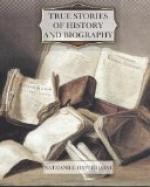“Would that I could see its walls crumble to dust!” thought the chief justice; and, in the bitterness of his heart, he shook his fist at the famous hall. “There began the mischief which now threatens to rend asunder the British empire. The seditious harangues of demagogues in Faneuil Hall, have made rebels of a loyal people, and deprived me of my country.”
He then passed through a narrow avenue, and found himself in King Street, almost in the very spot which, six years before, had been reddened by the blood of the Boston Massacre. The chief justice stept cautiously, and shuddered, as if he were afraid, that, even now, the gore of his slaughtered countrymen might stain his feet.
Before him rose the town house, on the front of which were still displayed the royal arms. Within that edifice he had dispensed justice to the people, in the days when his name was never mentioned without honor. There, too, was the balcony whence the trumpet had been sounded, and the proclamation read to an assembled multitude, whenever a new king of England ascended the throne.
“I remember—I remember,” said Chief Justice Oliver to himself, “when his present most sacred majesty was proclaimed. Then how the people shouted. Each man would have poured out his life-blood to keep a hair of King George’s head from harm. But now, there is scarcely a tongue in all New England that does not imprecate curses on his name. It is ruin and disgrace to love him. Can it be possible that a few fleeting years have wrought such a change!”
It did not occur to the chief justice, that nothing but the most grievous tyranny could so soon have changed the people’s hearts. Hurrying from the spot, he entered Cornhill, as the lower part of Washington Street was then called. Opposite to the town house was the waste foundation of the Old North church. The sacrilegious hands of the British soldiers had torn it down, and kindled their barrack fires with the fragments.
Further on, he passed beneath the tower of the Old South. The threshold of this sacred edifice was worn by the iron tramp of horse’s feet: for the interior had been used as a riding-school and rendezvous, for a regiment of dragoons. As the chief justice lingered an instant at the door, a trumpet sounded within, and the regiment came clattering forth, and galloped down the street. They were proceeding to the place of embarkation.
“Let them go!” thought the chief justice, with somewhat of an old puritan feeling in his breast. “No good can come of men who desecrate the house of God.”
He went on a few steps further, and paused before the Province House. No range of brick stores had then sprung up to hide the mansion of the royal governors from public view. It had a spacious court-yard, bordered with trees, and enclosed with a wrought-iron fence. On the cupola, that surmounted the edifice, was the gilded figure of an Indian chief, ready to let fly an arrow from his bow. Over the wide front door was a balcony, in which the chief justice had often stood, when the governor and high officers of the province showed themselves to the people.




